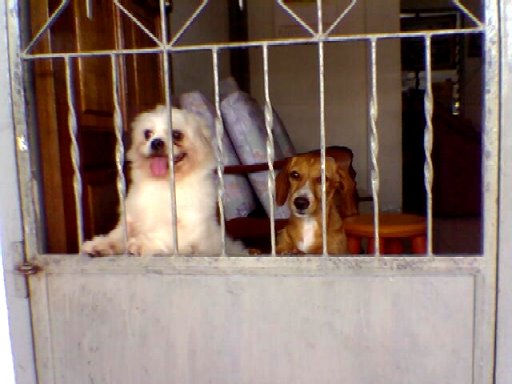Crates, Cages and Compassionate Canine Confinement
Ever think of sticking your dog in a crate? No, not the kind they use to ship things, but a cage designed specifically for dogs. Crating is just a creative term for caging your animal and is generally employed for early potty training or to keep a pet safe when circumstances dictate. Surprisingly, a dog will learn to love its crate but far too many people don't understand their purpose and think they are cruel (the crates, not the dogs).
When my sister came over to my house to meet my new puppy for the first time, she was shocked to see we had a crate for our dog. I wasnt surprised by her reaction when she first saw the crate. In fact, I expected it. Truth be told, many people feel the same way. I, myself, used to think that keeping a dog in a crate was down-right cruel until I learned that crate training can be a wonderful tool when it comes to caring for and even protecting your pup and something it will actually come to love.
The problem with crates is that, outwardly, they don't appear particularly kind. What isn't commonly known is that a crate can actually become a dog's sanctuary. Like the wolves from which they sprang, a dog likes a den and, in essence, that's what a dog's crate becomes once he is accustomed to it.
In time, your dog will learn to appreciate, even love his crate. My own dog, now 10 years old, still goes to her crate to nap or when she's frightened of a thunderstorm. We no longer need the crate for its original purpose (to adjust her potty habits to our work schedules) but have left it up simply because she wants it. We never even bother to close the door. It's just her special spot to rest and feel secure.
Not only will your dog eventually love its crate, but you will love come to love it too as a training tool and a means of keeping your dog safe. There are many times when it is beneficial to lock an energetic pup away for a few minutes. In our own experience, having the front door to the house propped open to move furniture or because workers are coming in and out is a perfect example of how short-term doggy-lockdown is the safest option for all involved.
It can't be stressed enough, however, that you must use your crate properly or you will completely defeat its purpose and risk emotional damage to your dog. First and foremost, don't leave your puppy in its crate for longer than five hours and only that if it's unavoidable (because of your job, for example). While the premise behind the crate is to play on your dog's instinct not to eliminate where it sleeps, even the strongest instinct can't win out against a young dog's bladder.
You must also never use your crate as a means of punishment. This isn't your dog's timeout-for-bad-behavior corner. You want your pup to think of its crate as a cozy, safe sanctuary, not someplace it desperately wants to avoid. Using it for punishment will only make your dog fear or resist being crated. Make the crate someplace it wants to go when it's time for a break. Keeping a favorite chew toy or one of your old socks (the scent will comfort him since it smells like his favorite person) in the crate will contribute to the crate being a sanctuary.
There are many different types of crates to choose from. In fact, you might even be overwhelmed by the selection! You do not want a crate that is too big or too small. Your dog should be able to lie down comfortably and be able to turn in a complete circle without difficulty. If you get a large crate (so that your dog can grow into it) you can purchase a divider so that he is not tempted to eliminate in one corner and sleep in the other.
Wire crates are probably your best bet. They allow better air flow and better viewing for your pup. At night, you can cover the wire crate with a blanket so that you form a den like atmosphere (your dog will like this!).
Crates can be wonderful training tools and a great sanctuary for your dog. But, if you really have difficulty stomaching a crate, a puppy play pen might be more your speed. Just don't expect the potty training benefits out of this alternative. At the very least, both a crate and a play pen will afford you a safe place to put your pup if needed (such as when your front door may be open for extended periods to accommodate workers).
When my sister came over to my house to meet my new puppy for the first time, she was shocked to see we had a crate for our dog. I wasnt surprised by her reaction when she first saw the crate. In fact, I expected it. Truth be told, many people feel the same way. I, myself, used to think that keeping a dog in a crate was down-right cruel until I learned that crate training can be a wonderful tool when it comes to caring for and even protecting your pup and something it will actually come to love.
The problem with crates is that, outwardly, they don't appear particularly kind. What isn't commonly known is that a crate can actually become a dog's sanctuary. Like the wolves from which they sprang, a dog likes a den and, in essence, that's what a dog's crate becomes once he is accustomed to it.
In time, your dog will learn to appreciate, even love his crate. My own dog, now 10 years old, still goes to her crate to nap or when she's frightened of a thunderstorm. We no longer need the crate for its original purpose (to adjust her potty habits to our work schedules) but have left it up simply because she wants it. We never even bother to close the door. It's just her special spot to rest and feel secure.
Not only will your dog eventually love its crate, but you will love come to love it too as a training tool and a means of keeping your dog safe. There are many times when it is beneficial to lock an energetic pup away for a few minutes. In our own experience, having the front door to the house propped open to move furniture or because workers are coming in and out is a perfect example of how short-term doggy-lockdown is the safest option for all involved.
It can't be stressed enough, however, that you must use your crate properly or you will completely defeat its purpose and risk emotional damage to your dog. First and foremost, don't leave your puppy in its crate for longer than five hours and only that if it's unavoidable (because of your job, for example). While the premise behind the crate is to play on your dog's instinct not to eliminate where it sleeps, even the strongest instinct can't win out against a young dog's bladder.
You must also never use your crate as a means of punishment. This isn't your dog's timeout-for-bad-behavior corner. You want your pup to think of its crate as a cozy, safe sanctuary, not someplace it desperately wants to avoid. Using it for punishment will only make your dog fear or resist being crated. Make the crate someplace it wants to go when it's time for a break. Keeping a favorite chew toy or one of your old socks (the scent will comfort him since it smells like his favorite person) in the crate will contribute to the crate being a sanctuary.
There are many different types of crates to choose from. In fact, you might even be overwhelmed by the selection! You do not want a crate that is too big or too small. Your dog should be able to lie down comfortably and be able to turn in a complete circle without difficulty. If you get a large crate (so that your dog can grow into it) you can purchase a divider so that he is not tempted to eliminate in one corner and sleep in the other.
Wire crates are probably your best bet. They allow better air flow and better viewing for your pup. At night, you can cover the wire crate with a blanket so that you form a den like atmosphere (your dog will like this!).
Crates can be wonderful training tools and a great sanctuary for your dog. But, if you really have difficulty stomaching a crate, a puppy play pen might be more your speed. Just don't expect the potty training benefits out of this alternative. At the very least, both a crate and a play pen will afford you a safe place to put your pup if needed (such as when your front door may be open for extended periods to accommodate workers).
About the Author:
You can find more dog care information at www.bunnyroobeagle.com. The site is full of fun pet-related ideas, recipes and tons of information on pet dog health.














.jpg)






.jpg)

0 comments:
Post a Comment